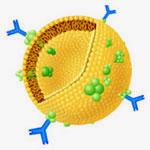Surface Modification of Liposomes

Proteoliposome |

Immunoliposome |
Modification of the liposomal surface is a very important tool for controlling the biological properties of liposomes. Attachment of certain specific ligands such as peptides, proteins (e.g. antibodies), hormones, sugars, metals (magnetic liposome) makes liposomes targeted; coating liposomes with polymers such as PEG (poly(ethylene glycol)) give the liposomes the ability to circulate longer in body without being recognized by reticulo enthothelial system cells; attachment of contrast agent converts liposome into a powerful diagnostic tool.
Numerous protocols have been developed by many research groups around the world for coupling the proteins, peptides, sugar etc to the liposomal surface.
Encapsula NanoSciences provides various formulations of surface modified liposomes. For more information send us an email at info@encapsula.com
Incorporation of the proteins into the liposomes
Membrane proteins such as bacteriorhodopsin, K+ channels, cyclooxygenase etc can be incorporated into the liposomes by various techniques such as
- Methods involving the use of organic solvent
- Methods involving the use of mechanical means e.g. French press
- Methods involving the use of detergents
- Direct incorporation of the proteins into the preformed liposomes
Binding of proteins and peptides to liposomes via amino acid groups
Protein conjugated liposomes and especially antibody conjugated liposomes have attracted a great deal of interest for their potential use as targeted drug delivery systems. Many techniques have been developed which are base on nucleophilic reactivity of free amino groups of the proteins or peptides. A two stage coupling procedure involving carboxyacyl derivatives of phosphatidylethanolamine is commonly used. In first stage a lipidic free carboxylic group is first activated with water soluble carbodiimide at pH=pKa-1, where pKa is the ionization constant of the given carboxylic group. In the second stage, protein or peptide solutions are added with a simultaneous change to pH 8.
Binding of proteins and peptides to liposomes via sulfhydryl groups
In this technique thiol reactive phospholipid derivatives can be conjugated with the thiol groups of the proteins. N-PDP-PE and N-MPB-PE are two examples of the thiol reactive phospholipids.
Binding of carbohydrates and other small molecules to the liposomal surface
Attachment of glycon-terminating ligand to the liposomal surface is very important for cell targeting. The sugar derivative can be covalently bound to the preformed liposomes containing NGPE.
Other small molecules such as folate and metal receptors etc can be attached to the liposomal surface. Numerous protocols have been developed for attachment of various types of molecules to the liposomal surface.
Encapsula NanoSciences provides various formulations of surface modified liposomes. For more information send us an email at info@encapsula.com
|

